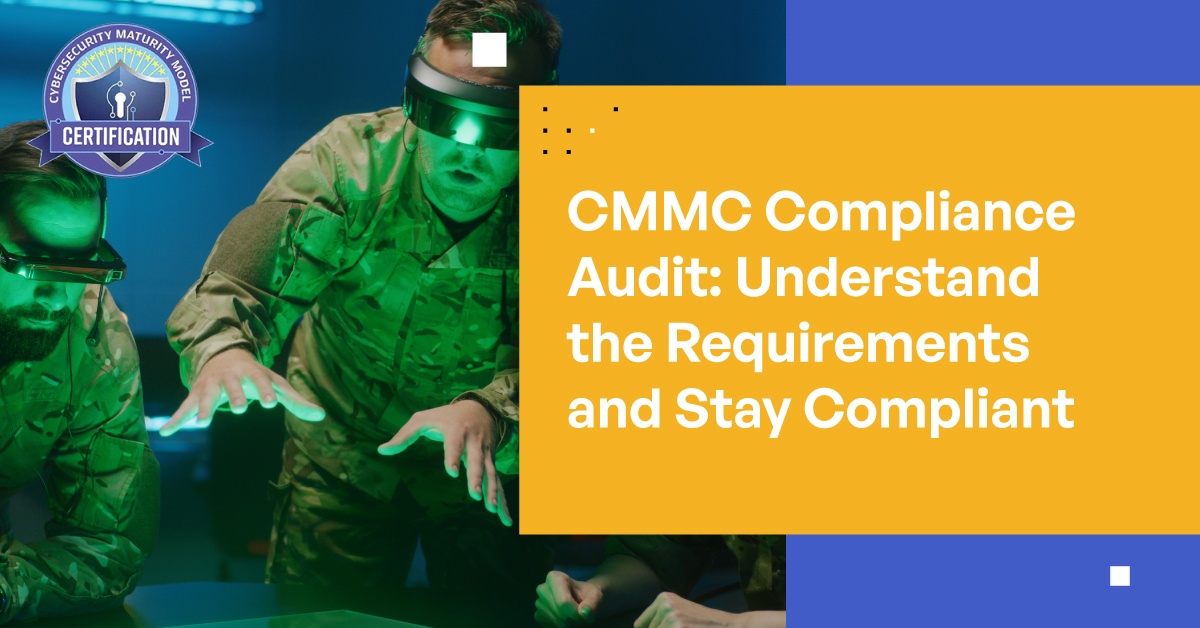CMMC Compliance Audit: Understand the Requirements and Stay Compliant
The Department of Defense’s (DoD) Cybersecurity Maturity Model Certification (CMMC) was created to ensure the protection of Federal Contract Information (FCI) and controlled unclassified information (CUI) within the defense industrial base (DIB). As organizations prepare for a CMMC compliance audit, it is essential to understand the key components that contribute to its success. Read on to learn the essential components of a successful CMMC compliance audit, including preparation, documentation, and continuous improvement.
What Is CMMC Compliance?
CMMC is a certification program that assesses an organization’s cybersecurity posture. The certification is intended to provide assurance that organizations are adhering to best practices for the protection of CUI and FCI when working with the DoD. CMMC compliance is a complex process that requires rigorous planning and detailed documentation. Organizations must adhere to the security and audit requirements necessary to demonstrate a comprehensive level of regulatory compliance. The goal is to develop a comprehensive and scalable security program that meets the guidelines set by the DoD. This is where organizations need to have a CMMC roadmap to compliance.

Overview of CMMC Compliance Audit
In order to work with the DoD, organizations must meet the requirements of the CMMC. CMMC Version 2.0, released in 2021, is the newest version of CMMC and it incorporates the previous version’s five different levels of certification, but adds additional criteria to each level. CMMC 2.0 contains three tiers of assessments based on the level of information access. They include:
Level 1: Foundational
Foundational level requires an annual self-assessment with attestation from a corporate executive. This level encompasses the basic safeguarding requirements for FCI specified in FAR Clause 52.204-21.
Level 2: Advanced
Advanced level is aligned with the National Institute of Standards & Technology Special Publication 800-171 (NIST SP 800-171). It requires triennial third-party assessments for DoD contractors that send, share, receive, and store critical national security information. These third-party assessments are conducted by CMMC Third Party Assessor Organizations (C3PAOs).
CMMC 2.0 Level 2 encompasses the security requirements for CUI specified in NIST SP 800-171 Rev 2 per DFARS Clause 252.204-7012 [3, 4, 5].
Level 3: Expert
Expert level is aligned with and will require triennial government-led assessments. Information on Level 3 will be released later and will contain a subset of the security requirements specified in NIST SP 800-172 [6].
To assist DoD contractors to achieve CMMC compliance, the CMMC Accreditation Body (CMMC-AB) authorized CMMC Third Party Assessor Organizations (C3PAOs) to help DoD contractors along the compliance journey. To achieve compliance with CMMC 2.0 mandates, DoD suppliers must appoint a C3PAO to assess their compliance.
Benefits of CMMC Compliance Audit
The benefits of CMMC compliance extend beyond satisfying contractual requirements. Organizations that attain CMMC certification demonstrate a commitment to cybersecurity and the protection of sensitive information. By adhering to best practices, organizations can reduce the risk of a data breach and the associated costs and reputational damage. Furthermore, CMMC certification can help organizations achieve regulatory compliance with other laws and standards, such as the Federal Risk and Authorization Management Program (FedRAMP) and the National Institute of Standards and Technology (NIST) Cybersecurity Framework (CSF). At the same time, those organizations that are FedRAMP Authorized are able to demonstrate compliance with certain practice requirements found in CMMC 2.0 Level 2 and Level 3.
Components of a Successful CMMC Compliance Audit
A successful CMMC audit requires the organization to meet the criteria of the three levels of CMMC. The components must be implemented correctly in order for the organization to demonstrate that their cybersecurity program is comprehensive, scalable, and accountable. The following are the components of a successful CMMC audit:
Risk Management Framework
The Risk Management Framework (RMF) is a critical component to any successful CMMC audit. Like other security risk management frameworks, the RMF outlines the policies and procedures that are necessary to demonstrate compliance with the CMMC requirements. It includes the documentation needed to demonstrate the scope of the CMMC assessment, risk assessment, and the steps taken to mitigate any risks identified. It includes policies and procedures for monitoring, reporting, and responding to changes or updates to the security environment, as well as a framework for evaluating the system’s compliance and security posture.
Security Documentation
Security documentation is a key component of a successful CMMC audit. The documentation outlines the system security architecture and how it is implemented. This detailed documentation should include the security configuration baseline, the system requirements, and the security assessments. It provides insight into how the system is configured and how security controls are maintained.
Continuous Monitoring Program
The Continuous Monitoring Program (CMP) is a monitoring procedure designed to track changes or updates to the security environment in order to ensure that the system remains compliant with CMMC requirements. It should include processes for identifying and responding to changes, such as patching or software upgrades. It should also include procedures for monitoring user access and data flows, as well as processes for detecting and responding to malicious activity.
System Security Plan
The System Security Plan (SSP) outlines the organization’s security policies, procedures, and the steps that must be taken to ensure system security. It should provide guidance on security objectives, security controls, and the processes in place to meet these objectives. The SSP should include information on incident response, data backup and recovery, and password policies. It should also address the use of encryption, user access control, multi-factor authentication (MFA), firewalls, and other security measures.
Certification and Accreditation Process
The Certification and Accreditation (C&A) process is used to validate the system’s security. This process is used to demonstrate that the system is compliant with the security requirements set by the DoD. During the C&A process, the system is assessed for security vulnerabilities and any noncompliant elements are identified and addressed. The C&A process should include testing and verification of system security measures, as well as the implementation of security policies and procedures.
Best Practices for a Successful Audit
Organizations should ensure that they implement several cybersecurity and data protection best practices for a successful audit. The following are a few best practices for CMMC compliance:
Implement the Risk Management Framework
The Risk Management Framework (RMF) is the starting point for a successful audit. Organizations should ensure that they implement the RMF and adhere to the documentation requirements. Third-party risk management (TPRM) and supply chain risk management both play an important role.
Document System Security Plan
Organizations should document their system security plan thoroughly to ensure that it meets the CMMC requirements. The plan should include the security requirements, the security controls, and the processes in place to meet those objectives.
Perform Continuous Monitoring
Organizations should ensure that they perform continuous monitoring to ensure that the system remains compliant with CMMC requirements. Continuous monitoring is used to identify any changes or updates to the security environment and ensure that the system is secure.
Participate in Certification and Accreditation Process
The Certification and Accreditation (C&A) process is used to validate the system’s security. Organizations should participate in the C&A process to ensure that the system is compliant with the DoD’s security requirements.
How Kiteworks Can Assist You in Your CMMC 2.0 Level 2 Compliance Journey
A successful CMMC audit requires the audited organization to meet the criteria of the desired CMMC level. The audit components listed above must be implemented thoroughly and correctly in order for the organization to demonstrate that their cybersecurity program is comprehensive, scalable, and accountable. By properly preparing for a CMMC audit, organizations can ensure that they maintain compliance with the latest cybersecurity standards set forth by the DoD.
Kiteworks is a trusted provider of cybersecurity solutions for DIB contractors seeking CMMC 2.0 compliance. Because the Kiteworks Private Content Network supports nearly 90% of CMMC 2.0 Level 2 requirements out of the box, organizations can accelerate their CMMC Level 2 certification process with C3PAOs. Further, FedRAMP Authorized for Moderate Level Impact is a key enabler, and one of the reasons Kiteworks achieves a much higher level of compliance across the CMMC practice requirements than other sensitive content communications solutions. Indeed, in addition to FedRAMP Authorized, FIPS 140-2, ISO 27001, 27017, and 27018, and SOC 2, among others.
For more information on the Kiteworks Private Content Network and how Kiteworks can accelerate your path to CMMC compliance, schedule a custom demo today.

